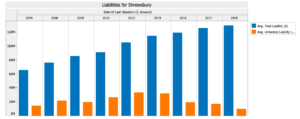MassPensions: The Leaders and Laggards among Massachusetts Public Pension Systems
As detailed in a recent study published by the Pioneer Institute, Massachusetts continues to put off fully funding its public pension plans. This is especially concerning since the interest that accrues from deferred payments dramatically increases the amount taxpayers ultimately have to pay.
To help inform citizens about the current status of the state’s 106 public pension systems, Pioneer’s MassPensions.com has graded each system. The main factor contributing to the grades is the expected year in which systems are projected to be fully funded. An “A” indicates that a system’s pension liability will be fully funded in less than 4 years, while an “F” indicates that it will be over 20 years before full funding is achieved. It is important to note that MassPensions has used the most recent data, which is from either 2017 or 2018, depending on the system. As a result, Pioneer has used 2017 as a base year for some systems and 2018 for others.
Although on the whole, public pension systems in the state are slacking, several systems have promising outlooks and are projected to be fully funded well before others. Three systems have received “As”, while six that received “Bs” follow close behind. Unsurprisingly, however, there are also many programs with dismal prospects, with a multitude of systems being given “Ds” in addition to two that received “Fs”.
Using MassPensions.com, one can find the highest and lowest rated systems, and all those in-between. Here are some of the best and worst performers:
Highest Rated Pension Systems:
Leominster (A+/A):
Leominster earned an “A”, with a system that was expected to be fully funded by 2020. In 2018, it had an unfunded liability of just $701,000, an impressive 96.4% lower than its unfunded liability of $19.2 million in 2017. This system has defied its already high expectations and is actually fully funded this year. Given this achievement, Leominster deserves an A+.
Massachusetts Port Authority (A):
The MassPort Authority uses a different actuarial cost method than other systems when assessing its fund, so it does not provide a year for full funding. However, its unfunded liability of $48,014,000 in 2018 was the lowest it had been since 2011, and its 2018 funded ratio of 90.9% was one of the highest in the state. Given these impressive stats, the MassPort Authority gets an “A”.
Shrewsbury (A):
Shrewsbury’s pension system has also earned an “A” and is anticipated to be fully funded by 2021. In 2018, its funded ratio was 92.4%, the highest level achieved between 2004 and 2018. Between 2012 and 2018, its unfunded liability dropped from $33.2 million to $9.8 million, a 70.5% decrease over six years.

Source: MassPensions.com
Boston City (B):
From 2012 to 2018, Boston City’s pension system gradually improved its funded ratio to 76.9% and it is expected to be fully funded by 2025. While this system receives a “B”, it is important to note that it had an unfunded liability of $1.5 billion in 2018, the same amount it was in 2016.
Dedham (B):
Based on the data, Dedham’s pension system should be fully funded by 2022, earning a “B” rating. In 2018, its funding ratio was the highest it had been between 2004 and 2018 at a laudable 94.7%. Moreover, its unfunded liability decreased considerably between 2012 and 2018, dropping by about 77.2% from $33.8 million to $7.7 million.
Lexington (B):
Lexington’s pension system also receives a “B” given that is expected to be fully funded by 2025. As of 2018, the system’s funded ratio was 87.2% and had been steadily improving since its 2012 low of 78.3%. The system’s unfunded liability also improved since 2012, and was $24.2 million in 2018.
Marlborough (B):
Marlborough’s pension system is projected to be fully funded by 2025 as well and accordingly earns a “B”. In 2017, its funded ratio was 76.4%, 10.2 percentage points higher than its funded ratio in 2013. Furthermore, its $45,894,000 unfunded liability in 2017 was lowest it had been between 2005 and 2017.
Stoneham (B):
The final pension system expected to be fully funded by 2025 is Stoneham’s, which deserves a “B”. The system’s unfunded liability of $28.2 million in 2018 was the lowest it had been since 2011. Additionally, Stoneham’s 2018 funded ratio of 75% was 10.5 percentage points higher than its ratio of 64.5% in 2014.
Watertown (B):
Projected to be fully funded in 2024, Watertown’s pension system receives a “B”. This system had an unfunded liability of $24.2 million in 2018, about 60.1% lower than its $60.6 million unfunded liability in 2013. Additionally, the system’s funded ratio of 88.2% was the highest it had been between 2004 and 2018.
| Pension System | Year Expected to be Fully Funded | Unfunded Liability | Funded Ratio | Grade |
|---|---|---|---|---|
| Boston City | 2025 | $1,500,000,000 | 76.9% | B |
| Dedham | 2022 | $7,700,000 | 94.7% | B |
| Leominster | 2019 | $0 | 100.0% | A+ |
| Lexington | 2025 | $24,200,000 | 87.2% | B |
| Marlborough | 2025 | $45,894,000 | 76.4% | B |
| MassPort | N/A | $48,014,000 | 90.9% | A |
| Shrewsbury | 2021 | $9,800,000 | 92.4% | A |
| Stoneham | 2025 | $28,200,000 | 75.0% | B |
| Watertown | 2024 | $24,200,000 | 88.2% | B |
Note: Based on each system’s most recent data from either 2017 or 2018, with the exception of Leominster which has been updated for 2019.
Lowest Rated Pension Systems:
Marblehead (F):
Since its 2008 peak of 89.9%, Marblehead’s funded ratio steadily decreased to 64.8% by 2018. From 2004 to 2018, the system’s unfunded liability increased from $12.4 million to $52.4 million, an unsettling 322.6% increase. Given these figures, this system gets an “F” and is not expected to be fully funded until 2040.
MBTA Retirement Fund (F):
In light of the recent controversy surrounding the MBTA Retirement Fund’s false reports of its unfunded liabilities, it comes as no surprise that this fund gets an “F”. From 2004 to 2017, its funded ratio dropped from 94.3% to just 56.7%. During the same time period, its unfunded liability rose from $160,804,000 to $1,226,200,000, resulting in a staggering 662.5% increase over 13 years. Given these stats, the expected year in which the MBTARF will be fully funded is unknown. Further analysis of this troubled fund can be found here, here, and here.

Source: MassPensions.com
Lawrence (D):
With a funded ratio of just 53% in 2018, the Lawrence pension system’s “D” rating is hardly shocking. This system is projected to be fully funded by 2038, one year later than the state’s target for fully funding pensions. The city’s poor management of its fund is apparent in the fact that its unfunded liability increased by about 61.7% between 2004 and 2016 to $215.4 million. On a more promising note, its unfunded liability decreased by $11.4 million between 2016 and 2018 to $204 million, coinciding with a 7.1 percentage point increase in its funded ratio.
Lowell (D):
Lowell’s pension system has shown little progress over the past few years and has earned a “D”. As of 2017, its funded ratio was 56%, only one percentage point higher than its 2015 ratio. In addition, the system’s unfunded liability rose consistently between 2011 and 2017, increasing by 50.6% from $179.2 million to $269.8 million. Given these stats, Lowell’s pension system is not expected to be fully funded until 2037.
Melrose (D):
Melrose’s pension system has also received a “D”, given that it too is not projected to be fully funded until 2037. From 2008 to 2017, this system’s unfunded liability increased by about 69.3%, from $34.9 million to $59.1 million. Furthermore, its funded ratio has failed to improve and was 57.5% in 2017, 7.1 percentage points lower than in 2008.
Milford (D):
Yet another pension system that got a “D” is Milford’s fund, which is also not projected to be fully funded until 2037. This system has made little progress with its funded ratio, which increased by just 3.1 percentage points between 2015 and 2017 to 60.9%. A more troubling statistic is that its unfunded liability rose by about 182.6% between 2005 and 2018, from $19 million to $53.7 million.
Peabody (D):
Between 2004 and 2018, the unfunded liability of Peabody’s pension system only grew, rising by 121.9% from $62.2 million to $138 million. Unsurprisingly, Peabody made little headway in improving its funded ratio over the past several years. While its 2018 ratio of 52.3% was the highest it had been since 2008, it’s significantly lower than the 62.1% level it was at in 2004. Given these statistics, this system is not expected to be fully funded until 2037 and has earned a “D”.
Pittsfield (D):
Pittsfield’s pension system is also not expected to be fully funded until 2037 and deserves a “D”. The system’s funded ratio of 48.3% in 2017 is the second lowest on this list. Between 2007 and 2017, Pittsfield’s unfunded liability grew from $75.4 million to $135.4 million, a 79.6% increase.
Quincy (D):
Quincy’s pension system has the lowest funded ratio of these systems, just 45% in 2018. Complementing this statistic is its unfunded liability of $425,112,000, which is 157.3% higher than its 2007 unfunded liability. Given these stats, Quincy’s system is not projected to be fully funded until 2037 and rates a “D”.
Wakefield (D):
Wakefield’s is the final pension system that is expected to be fully funded in 2037 and accordingly earns a “D”. Its funded ratio of 65.3% in 2018 is the highest among the lowest performing systems, but it’s still low. More disconcerting is the trajectory of its unfunded liability. Between 2008 and 2018, it increased by about 181.5% from $22.1 million to $62.2 million.
| Pension System | Year Expected to be Fully Funded | Unfunded Liability | Funded Ratio | Grade |
|---|---|---|---|---|
| Lawrence | 2038 | $204,000,000 | 53.0% | D |
| Lowell | 2037 | $269,800,000 | 56.0% | D |
| Marblehead | 2040 | $52,400,000 | 64.8% | F |
| MBTARF | N/A | $1,226,200,000 | 56.7% | F |
| Melrose | 2037 | $59,100,000 | 57.5% | D |
| Milford | 2037 | $53,700,000 | 60.9% | D |
| Peabody | 2037 | $138,000,000 | 52.3% | D |
| Pittsfield | 2037 | $135,400,000 | 48.3% | D |
| Quincy | 2037 | $425,112,000 | 45.0% | D |
| Wakefield | 2037 | $62,200,000 | 65.3% | D |
Note: Based on each system’s most recent data from either 2017 or 2018.
Stayed tuned for more updates on MassPension.org; let’s hope more systems will have earned an “A”!
Cole Kroninger is a Roger Perry Transparency Intern at Pioneer Institute. He is a rising senior at Hamilton College where he studies Economics.



